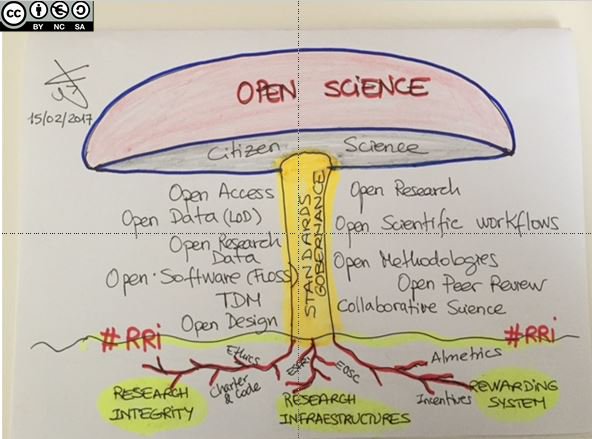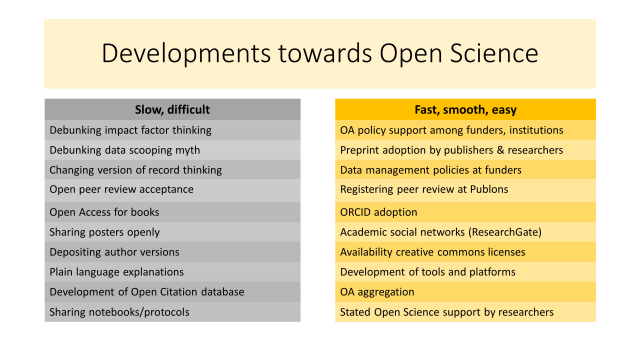In het Verenigd Koninkrijk (en daarbuiten) doet de UK Scholarly Communications Licence veel stof opwaaien. Het plan is gebaseerd op het Open Access Policy model van Harvard (https://osc.hul.harvard.edu/modelpolicy/), maar aangepast aan de situatie in het Verenigd Koninkrijk.
Het plan
Het gaat om een plan waarin onderzoekers via een overeenkomst hun instelling het recht geven de wetenschappelijke artikelen te verspreiden:
“authors grant the organisation a non-exclusive licence to make the manuscript of a scholarly article publicly available under a Creative Commons licence that allows non-commercial re-use (CC BY NC). This arrangement pre-dates any contract authors might sign with a publisher, which allows the host organisation to license the rights back to the author after they signed the copyright transfer agreement. This process ensures that academics can retain rights and do not have to negotiate with the publisher. To be legally binding, publishers must be notified – but this is something research institutions working with sector bodies will undertake jointly, so that authors have no additional work.”
(bron: https://doi.org/10.5281/zenodo.375830)
Omdat deze overeenkomst vooraf gaat aan afspraken die auteurs met de uitgevers/tijdschriften maken, kan de instelling op het moment van publiceren het artikel openbaar maken in een repository en is daarbij niet gebonden aan de embargo periode van het betreffende tijdschrift. Dit maakt dat altijd aan de voorwaarden van onderzoekfinanciers kan worden voldaan.
Auteurs kunnen wel per artikel een “waiver” aanvragen, net als bij de Harvard policy, maar dit is beperkt tot een periode van twee jaar na publicatie (of korter, dit is niet duidelijk).
Veel is nog onduidelijk over dit initiatief. Wat is de precieze inhoud van de licentie, welke instellingen gaan deze implementeren, hoe en wanneer? De bijbehorende website (http://ukscl.ac.uk/) is nog steeds onder constructie. De discussies over het plan zijn deels gebaseerd op aannames en interpretaties van wat er in de licentie zou kunnen staan.
De reacties
Er zijn een aantal reacties verschenen op de UK Scholarly Communications License.
De Publishers Association is “deeply concerned”. Zij stelt in haar reactie onder andere dat het voortbestaan van de tijdschriften in gevaar komt bij een korte embargo periode of OA beschikbaarheid van een artikel direct na publicatie. Daarom zijn uitgevers wel gedwongen om van onderzoekers te eisen dat zij een “waiver” aanvragen. En dat zal voor die onderzoekers weer een enorme werklast betekenen. Daarnaast signaleert ze dat dit plan in strijd is met het bestaande beleid in het Verenigd Koninkrijk waar juist Gold OA wordt gepropageerd, in plaats van Green OA.
Op The Scholarly Kitchen hebben twee historici een reactie geschreven op de UK Scholarly Communications License, vanuit de overtuiging dat “One of the most important lessons of the debates and policy shifts around Open Access (OA) has been the hard-won recognition that no one size fits all”. De auteurs van dit stuk delen de zorgen van de Publisher Association (waarnaar ze ook expliciet verwijzen). Ze voegen daar het gebruik van bronmateriaal in geesteswetenschappelijke publicaties (handschriften, kunstwerken e.d.) aan toe, wat maakt dat je niet zomaar je instelling het recht kan geven het artikel te verspreiden. Ook maken zij vanuit de Geesteswetenschappen bezwaar tegen de keuze voor CC-BY-NC in plaats van CC-BY-NC-ND.
“Because the formulation of text in argument is the primary research output, derivative use is not as applicable or desirable as it might be for other fields. That is, we produce essays with interpretive arguments, not data or experimental findings.”
In de reacties onderaan het stuk komt met name de mogelijkheid van ongeautoriseerde vertalingen naar voren als ongewenst effect. Gelukkig is er ook aandacht voor text mining en in hoeverre een CC-BY-NC-ND licentie text mining (on)mogelijk maakt.
De Nederlandse ambitie?
De Nederlandse ambitie opgeschreven in het Nationaal Plan Open Science is 100% Open Access in 2020 voor alle wetenschappelijke publicaties en direct bij publicatie. 100% en direct bij publicatie, de Nederlandse ambitie staat (in ieder geval op papier) geen uitzonderingen toe. Ook verwijst het nationale plan expliciet naar (delen van) boeken, waar de Harvard OA policy en de UK Scholarly Communications Licence alleen op artikelen van toepassing zijn.
Een NL Scholarly Communications Licence zou dus nog ingrijpender moeten zijn dan de licentie voor het Verenigd Koninkrijk om aan de Nederlandse ambities te voldoen. Of er concrete plannen zijn in Nederland weet ik niet, maar het nationale plan lijkt die mogelijkheid wel open te laten: “Er is ook aandacht nodig voor het eigenaarschap van publicaties uit onderzoek, om zonder kosten hergebruik te bevorderen.”
De vraag is ook hoe een NL Scholarly Communications License binnen de Nederlandse wetgeving zou werken. Gaat zo’n afspraak tussen onderzoeker en instelling in Nederland ook vooraf aan het contract met de uitgever?
Het amendement van Taverne op de auteurswet is in ieder geval onvoldoende om de ambitie van 100% open access te halen. Daarin is immers sprake van beschikbaar stellen “na verloop van een redelijke termijn” en dus niet direct. Er is sprake van “een kort werk”, waarmee boeken buiten de boot vallen. En het is onduidelijk (in ieder geval voor mij) of deze Nederlandse wet wel van toepassing is op contracten met buitenlandse uitgevers.
Tenslotte, een ambitie is geen eis. Hoe zet je een Scholarly Communications License eigenlijk in? Is het een norm die je stelt, waar onderzoekers bewust en beredeneerd van kunnen afwijken door middel van waivers? Dit lijkt op de oorspronkelijke aanpak van Harvard en is in lijn met de aanbevelingen van het Harvard Open Access Project. Of is het een harde eis die je stelt, waar academische vrijheid en de mogelijkheid om te publiceren waar je wilt ondergeschikt aan is? Dit is de kant die de UK Scholarly Communications License op lijkt te gaan, in ieder geval als je de critici mag geloven.














